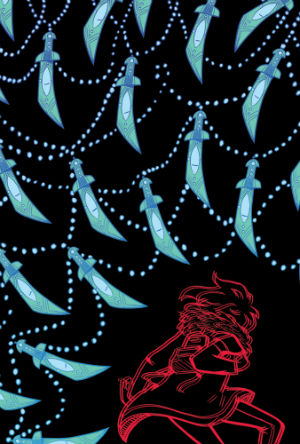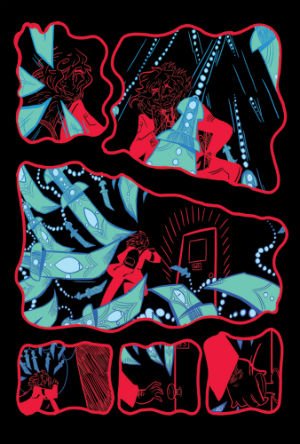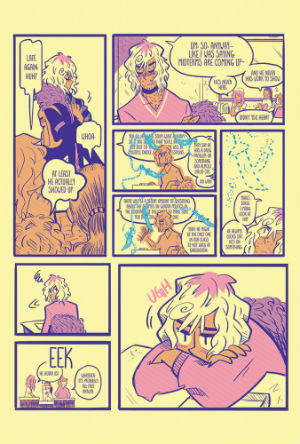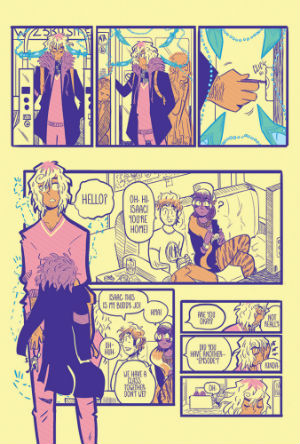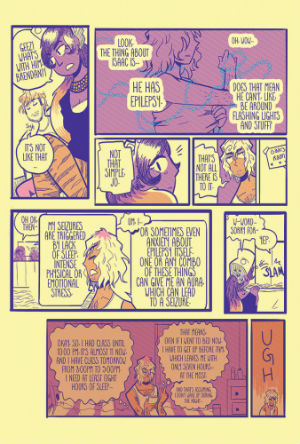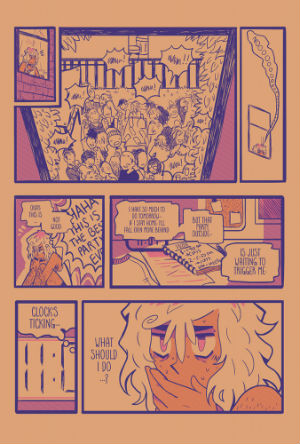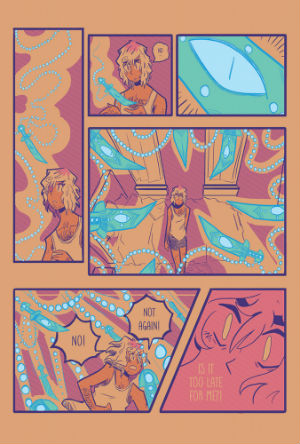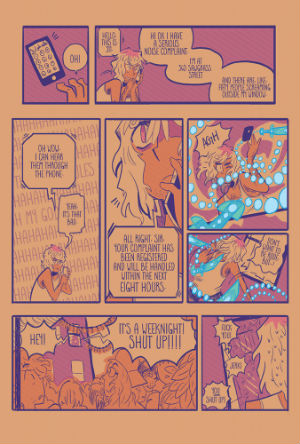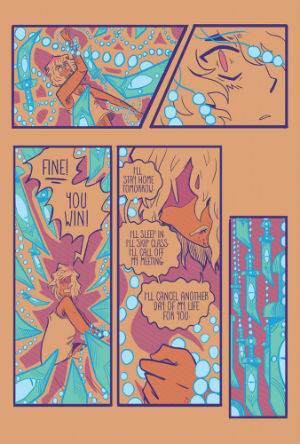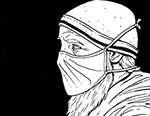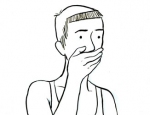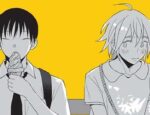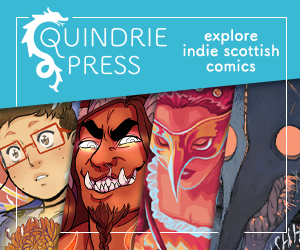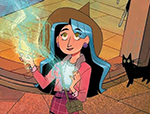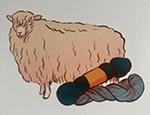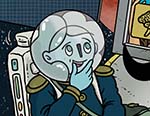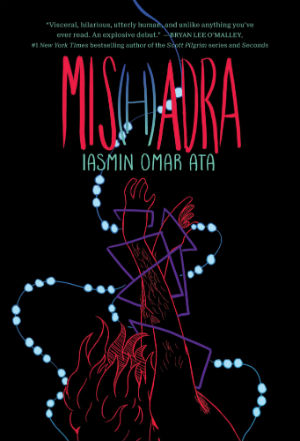 It is always heartening to see a cartoonist at an early stage in their career getting the opportunity to do large-scale paid work as is the case with Iasmin Omar Ata’s Mis(h)adra published by Simon and Schuster imprint Gallery 13. While the graphic novel represents the finalized form of a story Omar Ata had been releasing as a webcomic, it suffers from several inconsistencies that undercut the more profound parts of the book. As the majority of these are conceptual or technical issues it becomes difficult to gauge whether the issues stem from Omar Ata themselves or from the publisher’s editing. In either case, it keeps a book that has several brilliant sections from coming together as a complete whole.
It is always heartening to see a cartoonist at an early stage in their career getting the opportunity to do large-scale paid work as is the case with Iasmin Omar Ata’s Mis(h)adra published by Simon and Schuster imprint Gallery 13. While the graphic novel represents the finalized form of a story Omar Ata had been releasing as a webcomic, it suffers from several inconsistencies that undercut the more profound parts of the book. As the majority of these are conceptual or technical issues it becomes difficult to gauge whether the issues stem from Omar Ata themselves or from the publisher’s editing. In either case, it keeps a book that has several brilliant sections from coming together as a complete whole.
The overall focus of Mis(h)adra is its most unassailable quality, for in this respect it is a singular work. The plot follows protagonist Isaac five years into his chronic bout with epilepsy and his slow acceptance of both his disease and the need for a support structure that will help him cope with it. What makes the work stand out is that unlike many other graphic narratives dealing with disease not only is this one is fictional (though based on the creator’s own direct experience) it also comes from the perspective of someone in their early twenties. It is refreshing to see such a new take on the narrative of chronic illness, one in which the protagonist not only should be in the prime of their lives but is not.
So much of Isaac’s suffering comes not from his disease, but from the people around him being unable to comprehend it. In drawing from personal experience Omar Ata carefully details all the idiosyncrasies of Isaac’s epilepsy in a way that makes the reader far more aware of the obstacles he faces than the majority of characters surrounding him. It is because we know his struggle that we feel a deep empathy for him when both doctors and his family are dismissive of illness. In a masterful turn, many of Isaac’s own college-aged peers are equally blind to the difficulty of his everyday life. Young and invincible they loudly party late into the night unaware of the myriad triggers that can induce a seizure in Isaac. When he calls in a noise complaint on a raging drunken party outside his window, the reader know enough about how detrimental it is for him to not get a good night’s sleep that we are firmly on his side.
The dialogue also deserves special mention, as for the majority of the book it is pitch perfect. Omar Ata has to thread a very thin needle in eliciting sympathy for Isaac instead of exasperation and does so effortlessly. Even when it needs to be expositional, both the inner and external dialogue has a nice naturalistic flow. Paired with some strong facial performances, it gives both Isaac and his will–they-won’t-they love interest Jo their own distinct voices. The main stumbling block comes near the end of the book where the two share several deeply unguarded moments, yet perhaps in trying to be more direct about the work’s message the dialogue becomes rather ham-handed. This is unfortunate as, up until that point, much of that message had been deftly woven into the text in a way that matched the loose storytelling.
The conceptual approach to the artwork is also inconsistent, though not in execution. Drawing in a hybrid manga-influenced style on never-white pages that blend yellow, purple, blue, black, orange, and red; Omar Ata does a strong job of capturing the emotional performance of their characters. However the work suffers when it relies too casually on the storytelling choices of Eastern comics. Rarely do we see characters framed in anything other than an above the shoulder close up or above the waist medium shot. Establishing shots are equally rare as is anything beyond a loosely sketch setting. It can’t be from a lack of technical proficiency as when Omar Ata does goes all the way with rendering more complex locations and figures they do a fine job. Many of those panels stand out as memorable or evocative, such as a wide shot of a party or a close up of Isaac’s hand amid shattered glass, but they are few and far between.
This lack of strong panels per page only intensifies as in the latter half of the book Omar Ata tends to use, on average, less panels per page. In early sections the tight pacing reduced the need for more fleshed-out compositions, but when things slow down the stark emptiness of many of the frames becomes all the more apparent. One of the ways this is counteracted is in the use of the supernatural imagery that surrounds Isaac, representing not only the symptoms of his disease but the accompanying anxiety.
The reoccurring blue daggers with eyes on their blades is a gripping image whose meaning is given greater context in the conclusion where the eyes are linked to the eyes of bystanders viewing the epileptic, making Isaac’s true terror not his illness but the fear of how people will view him because of it. Unlike the occasional digital blurring of the linework on pages where Isaac is suffering from a seizure, the eyes are an advanced and subtle gesture on Omar Ata’s part. As with the aforementioned clunky dialogue, Omar Ata should trust themselves more to deliver their message subtly, bringing the reader in by letting them perform more of the closure.
Whatever the source of these unpolished portions of Mis(h)adra, the book stands out for trying to tell an untold story and telling it well. It will be interesting to see where Omar Ata goes next with their work, be it leaning into the slice-of-life portions of the book or further developing their unique ability to make the unseen world visible. Even continuing the intercutting of the two should prove interesting. In any case, they have plenty of time to improve their craft but this is a compelling debut.
Iasmin Omar Ata (W/A) • Gallery 13, $25.00
Review by Robin Enrico





